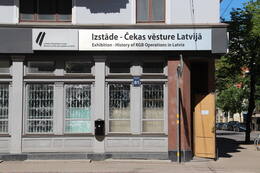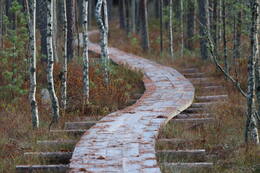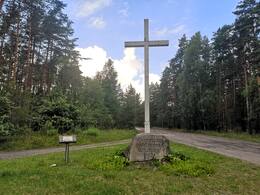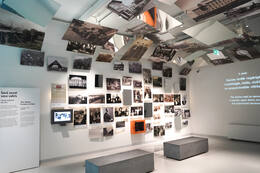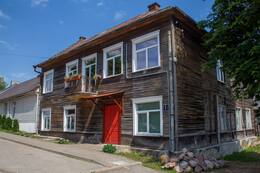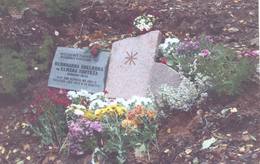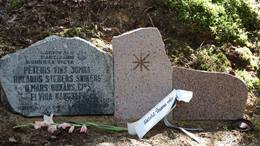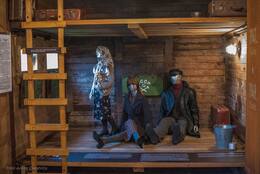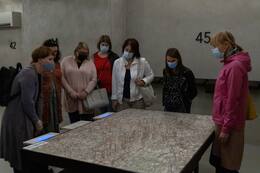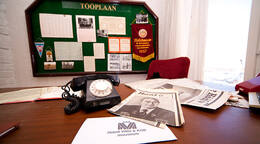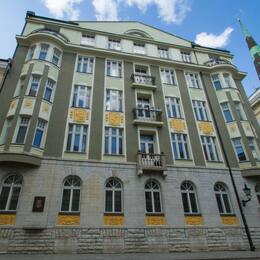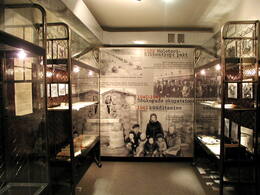Cheka II World War II
One of the pillars of power in the USSR was a special repressive structure, popularly known as a check. It was established by the Bolsheviks shortly after the establishment of their power in Russia in December 1917. An all-Russian emergency commission was set up to search for and physically combat Bolshevik opponents. The name of the commission in Russian - Vserossijskaya Črezvichainaya The commission was abbreviated - Czech. This created a name for the entire repressive system in later years, regardless of how its official name changed.
On June 17, 1940, together with the regular USSR troops, special units of the internal troops entered Latvia and began operating as a check. It operated in Latvia until 1991 and is responsible for the death, physical and moral suffering of thousands of Latvian citizens.
The operation of the check in Latvia is closely related to the building on the corner of Brīvības and Stabu streets. Reconstruction of the institution began shortly after the occupation began in September 1940. He was imprisoned there, interrogated, and in 1940-41. also killed Latvian citizens, who were considered opponents of the occupation regime. In 1940 and 1941, at least 3355 political criminal cases were initiated. Many detainees were later found in mass graves in Baltezers, Babīte, Dreiliņi, Stopiņi, as well as in the courtyard of Rīga Central Prison. At the end of the war with Germany, at the end of June 1941, Chekists took about 3,600 political prisoners to USSR prisons. In general, the political persecution of 1940-41 Around 26,000 Latvians were directly affected in.
The fighting against opponents of the Soviet power continued after World War II, and was mainly directed against the Latvian national partisans and members of the anti-Soviet resistance movement. An investigation took place in the corner house in the post-war years, but executions took place in Riga Central Prison. The Czech way of operating changed slightly after Stalin's death in 1953. Physical torture was replaced by psychological.
In later years, when resistance to the Soviet regime was effectively suppressed, physical repression was rare, but the check still controlled society and kept it in the grip of fear. The methods of operation of the check in Latvia have not been studied in detail and completely due to the lack of documents. In Latvia, investigation files and check cards for freelance agents are kept, but employee lists and service files are located in Russia. They are not available to Latvian authorities and researchers.
More information sources
Latvian Occupation Museum / What was a check? Available: http://okupacijasmuzejs.lv/lv/apmekle/izstade-cekas-vesture-latvija/kas-bija-ceka/ [accessed 06.05.2021]
Related timeline
Related objects
Exhibition in the KGB Building "History of KGB Operations in Latvia"
The former USSR State Security Committee (commonly known as Cheka) building is open for visitors. Here chekists imprisoned, interrogated and murdered Latvian citizens who were considered opponents by the occupation regime. There is also an exhibit from the Latvian Occupation Museum on the activities of Cheka in Latvia. Guided tours of the prison cells, corridors, basement and courtyard are available. The house was built in 1911 and it is one of the most beautiful buildings in Riga. Called the ‘Corner House’ by the people, it was the scariest symbol of the Soviet occupation regime in Latvia, and also one of the pillars of power of the USSR. Cheka operated from the Corner House during the occupation from 1940 to 1941 and then again from 1945 to 1991. Tens of thousands of Latvians were affected by direct political persecution. The fight against enemies of Soviet rule continued also after World War II. Cheka’s approach towards its operation slightly changed after Stalin’s death. Physical torture was replaced by psychological terror. The majority of Cheka agents were Latvians (52%). Russians were the second largest group – 23.7%. 60.3% of the agents were not members of the Communist Party. 26.9% of the agents had higher education. The system was designed in a way to involve local people and thus have greater control over the society. Staff documents and service records are located in Russia. And these materials have not been made available to Latvian authorities and researchers.
Trail and partisan memorial in Stompaki bog
During World War II, one of the largest national partisan camps in the Baltic states was situated in Stompaki Swamp. Today, the territory is included in the nature reserve “Stompaki swamp”. The settlement sites located on the islands in the swamp can be reached via a marked footpath.
In early 1945, about 350 to 360 people, including 40 to 50 women, lived at the camp of National Partisans in Stompaki Swamp. The camp consisted of 24 residential bunkers – buildings that were half-immersed into the ground and could accommodate 3–8 people. There was a bakery, a church bunker and three above-ground rails for horses. Partisans from the camp carried out attacks against officials of the occupation regime. On 2–3 March 1945, the Battle of Stompaki took place here – the largest battle in the history of Latvian national partisans. The 350–360 partisans in the camp were attacked by the 143rd Rifle Regiment of NKVD and local fighters of the so-called ‘istrebitel’ (eliminators) battalion – 483 men in total. The battle lasted for the entire duration of the day on 2 March. On the night of 3 March, the partisans managed to break out of the camp and retreat to their previous base camps. The battle resulted in 28 casualties among partisans, while the NKVD force lost 32 fighters.
Today, the site of the Stompaki camp is home to three restored bunkers – a church, a headquarters and a residential bunker – as well as 21 sites of former bunkers. Information boards about the camp and the battle have been installed at the site. Guided tours can be booked.
Memorial "White cross" in Stopiņi
Located in the forest 50 m from the highway V36, in the section from the village of Jugla paper factory to the highway P4.
Between February 3 and March 25, 1941, the remains of 23 people were described in four pits at the site. The victims were shot in a check building in Riga. The exhumation took place on April 27, 1944. At that time, 14 burials were identified, today, as a result of research, all those buried in this place have been identified.
The White Cross was erected at the site on July 12, 1991, as a memorial to the victims of the communist occupation. The White Cross was made and installed by the folk fronts and residents of Stopiņi County. In 1998, a memorial stone made by the sculptor Uldis Stergs with the inscription "Victims of the Russian Empire in 1941" was erected near the White Cross.
Buried here: Jānis Bergmanis (1900-1941), Alberts Bļodnieks (1904-1941), Kārlis Goppers (1876-1941), Arveds Laane (1916-1941), Ernests Ošs-Oše (1882-1941), Antons Pacevičs (1901 -1941), Joseph Poseiko (1897-1941), Arnold Smala (1912-1941), Joseph Stoller (1903-1941), Valfrid Vanx (1888-1941), Zenon Vyaches (1904-1941), Viktor Kopilov (1904-1941) ), Kārlis Prauls (1895-1941), Artūrs Salnājs (1904-1941), Jevgenijs Simonovs (1896-1941), Eduards-Verners Anerauds (1897-1941), Ephraim Gorons (1910-1941), Pēteris Ļaksa-Timinskis (1913 -1941), Pēteris Melbārdis (1892-1941), Israel Paļickis (1911-1941), Jānis Priedītis (1897-1941), Jānis-Arnolds Stālmanis (1913-1941), Aleksandrs Veinbergs (1884-1941).
Museum of the Occupation of Latvia
The museum exhibits the history of Latvia from 1940 to 1991, under the occupation of Nazi Germany and the Soviet Union. ‘House of the Future’ is a reconstruction and expansion project of the Occupation Museum designed by the well-known American Latvian architect Gunārs Birkerts as well as the new exhibit of the museum. The exhibit ‘History of Cheka in Latvia’ was created by the Occupation Museum and it is located in the ‘Corner House’, which is the former USSR State Security Committee (KGB) building. Latvian Occupation Museum was founded in 1993. It tells the long-hidden story of the fate of the Latvian state, nation and land under the occupation of two foreign totalitarian powers from 1940 to 1991. At the end of 2020 the museum had more than 70,000 different historical items (documents, photographs, written, oral and material evidence, objects and memorabilia). Museum specialists have recorded more than 2,400 video testimonials, making it one of the largest collections on occupation in Europe. The events that unfolded in Latvia, Lithuania and Estonia clearly show us what the nations had to endure under the two totalitarian regimes.
Monument "Grieving mother" at Inčukalns Cemetery of Honour
Located: Inčukalns district, Inčukalns, Miera street, Inčukalns cemetery.
The monument was unveiled on July 16, 1944. The monument was discovered after the death of K. Zāle. Inscription: On the partisans who fell to the Fatherland in 1941 (restored). The monument was restored on November 5, 2020. The monument was restored with the support of Inčukalns County Council. Restorer artist Igor Dobichin.
Events: “1940. On June 17, Latvia was occupied by the USSR. On June 14, 1941, deportations took place. On June 22, 1941, Germany attacked the USSR and parts of the Wehrmacht entered Latvia. The Red Army and its supporters withdrew. In many places in Latvia - including Ragana, Sēja and Inčukalns - former guards and patriotic young people organized to protect their homes and hurry to expel the Soviet occupiers. When the flag of the Free State of Latvia was hoisted again on July 1, 1941 in the sown parish "Ziediņi", special units of the Red Army at the Northern Cemetery shot the owner of this house - 39-year-old Elza Viša, but on the border of Sēja and Krimulda parish her mother - 64-year-old Elza Martinovu. The residents of the area caused even more hatred and outrage, and they began to gather in the popular resistance movement and form self-defense units, which were also called the first partisans (the leader of the Inčukalns group was Maksis Cālītis). Soldiers and officers who had escaped from the Litene military camp or were released from the so-called Latvian territorial corps also joined the fighters of the county. An armed clash with the Reds took place a few days later, on July 4, seven soldiers and the son of Ragana's pharmacist Pēteris Prašķēvičs fell. In addition, Jānis Porietis, a 17-year-old student of the Rēzekne Teachers' Institute, was injured and captured in the Battle of Ragana and tortured, shot and buried near Straupe.
Here in Inčukalns, a common grave of the brothers was excavated, to which coffins made of white unplaned boards were brought in eight horse-drawn carriages to lay the fallen heroes in their homeland. A few months later, already during the German occupation, a monument was erected in the cemetery by Kārlis Zāle (from 1939 until the end of his life on February 19, 1942, due to a serious illness, the genius Latvian sculptor chose Inčukalns as his residence) - the image of a mourning mother over a rose lap. In the 1950s, local Communist Party activists blew up the monument. The monument was damaged and stagnant until the Awakening, when in the late 80's more and more people became interested and talked about the events of July 4, 1941 and called for the restoration of the monument to Charles Hall. Such a demand was made at the meeting of people and power convened at Inčukalns Primary School on September 8, 1988, which was attended not only by Inčukalns residents, but also by residents of nearby parishes, as well as members of the Environmental Protection Club and LNNK from Riga.
In The people of Inčukalns - Teodors Ildens, Arvīds Blaus, Pēteris Vorfolomējevs -… and many other patriotic people actively participated in the restoration of the monument. On July 4, 1989, in a solemn ceremony, the reborn noble and sad tabby was consecrated by Pastor Vaira Bitena. ”
General Karl Gopper Memorial Room in the Muscat Hometown
Located in Plāņi Parish on the bank of the Vija River.
The memorial room of General Karl Gopper in his native house "Muscat" can be seen.
The Muscat farm was run by the general's brother, August Goppers, because the talented warlord was busy with major events and world wars. In 1920, the general returned to Latvia, to his native home. But many responsible duties connected him with Riga. August continued to operate in Muscat. In 1940, General Gopper was arrested and shot on March 25, 1941, in a check cellar. In 1944, the Gopper family went to Kurzeme as refugees with three horse-drawn carriages. The war divided the family, Alexander Gopper's daughters - Biruta, Elza and Anna - remained in Latvia. They were not allowed to return to Muscat. The houses were large and carefully maintained. Three four newcomer families were accommodated in separate rooms. A horse farm was set up in the big barn. A fire broke out in 1980 due to mutual scabies. The barn and the big barn burned down. Fortunately, the fire did not spread to the house, the flames were repelled by large trees planted by our ancestors.
In 1991, after the miraculous Awakening, the Latvian state was reborn for the second time. In 1992, the family of General Gopper's brother Augustus regained Muscat as an ancestral sanctity. For ten years, all the cheeses worked hard to save the houses from destruction, to restore and build the ruined buildings to make the entire Muscat farm beautiful. The houses have been restored to their old appearance, there is also a memorial room for General Karl Gopper. The memorial room can be visited in advance by calling +371 29396870, +371 29254285.
Monument to members of the resistance movement in Stompakis
It is located 15 km from Balvi in the direction of Viļakas, on the right side of the road.
A memorial is visible.
The memorial to the members of the resistance movement, dedicated to the memory of the national partisans of Pēteras Supes who fell in the battles of March 2 and 3, 1945, on the side of the Balva - Viļaka highway opposite the Stompaki swamp, was opened on August 11, 2011, on the day of remembrance of Latvian freedom fighters. At the end of July, a capsule with a message for future generations was embedded in the base of the monument. A document with the names of 28 national partisans who fell in the battles of March 2 and 3, 1945 is placed in the capsule.
"In February 1945, Latvia's largest national partisan camp was established on the islands of the Stompaku swamp, which the people began to call the islands of the Stompaku swamp, 2 km from the Balvu - Viļaka highway, where 360 people lived in 22 dugouts. Among them, some legionnaires who, for the legion division retreating, they had stayed at their father's house with all their weapons. In order to destroy the partisans, on March 2, 1945, the soldiers of two battalions of Czech troops attacked the dugouts together with destroyers, which also had four mortars in their armament. The battles took place all day, the partisans resisted stubbornly, and the attackers suffered suffered great losses, so that they could not capture the camp and destroy the partisans. 28 inhabitants of the Stompaku swamp had also fallen or died after being seriously injured in the battle. The next night, the partisans broke the siege of the camp with a battle and left undefeated" - this is what a member of the national resistance movement of the award department writes about the Stompaku battle chairman of the case commission, Zigfrīds Berķis.
Monument to the commander of the North-Eastern national partisans Pēteris Sup - "Cinītis"
Honoring the memory of the national partisan commander Pēteras Supes, on May 28, 2005, a monument dedicated to him was unveiled in Vilakas. It is placed near the Viļaka Catholic Church, on the edge of the trenches dug during the war, where the Chekists buried the shot national partisans. A capsule with the names of 386 fallen national partisans, battle descriptions and materials about the partisan commander is placed under the monument dedicated to P.Supem. The words engraved in stone: "I remained faithful to you, Latvia, until my last breath".
The monument was created by Pēteris Kravalis.
Next to it is a memorial place in the Stompaki forest and other places of battle for Latvian freedom fighters who fell and were murdered by the Chekists in 1944-1956.
On June 20, 2008, a granite plaque with the names of 55 fallen partisans arranged in three columns was discovered on the right wall.
The monument was erected in the place where the communist occupation authorities once displayed the remains of the murdered partisans to intimidate the rest of the population.
Words of thanks to Pēteris Supe and a poem by Bronislava Martuževa are engraved on the adjacent plaque:
"Get up, Peter Supe,
Soul, in battle!
Today Your blood sacrifice,
Risen in the nation.
Go out to live forever
In the strength and vigor of the young,
Wraps, flutters, folds
In the rising flag!"
Private Exhibition “Abrene Rooms”
The Private exhibition “Abrene Rooms” is located in the town of Viļaka, in a building with a diverse history. Initially, the building was located on the old Marienhausen market square, later it housed apartments, offices and various shops, and during World War II, it was the Latvian self-defence headquarters, the Gestapo and also the Cheka. Several exhibitions reveal diverse events and historical periods in the town of Viļaka and its nearest vicinity covering the time period from 1920 to 1960 when Viļaka was part of Jaunlatgale, later Abrene, district. The exhibit features items from the national partisan camp in Stompaki Swamp, which are related to the national partisan movement in the Latgale region. Documents and photos associated with the War of Independence are also on display. The latest exhibition is dedicated to the once-famous motocross track “Baltais briedis”.
Memorial plaque to Veclaicene national partisans instead of a bunker
Located in Veclaicene parish, Alūksne region.
Opened on October 4, 2019. Akmeņkalis Ainārs Zelčs.
On March 13, 1953, in the forests of Veclaicene, not far from the Koruļi house, the Chekists opened a carefully disguised bunker and arrested Bernhard Ābelkok and Elmārs Tortūze.
Weapons were found in the bunker: 2 German rifles and 95 rounds, 2 Parabellum pistols and 152 rounds.
On November 11, 1949, Czech agents K. Dokti-Doktenieki were shot and his group broke up. After the attack, B. Ābelkoks and E. Tortūzis hid for some time in a bunker near the Maskaļi house, but from the spring of 1951, with the support of Ilona Ābolkalns, they built a bunker in Koruļi, where they lived until their arrest.
Memorial to the bunker of the national partisan group "Jumba"
Located in Ziemera Parish, State Forest Quarter 66.
The memorial site was unveiled on July 10, 2020.
In the second stage of the Latvian national partisan movement, in the middle of 1948, a group of 4 people - Viks Pētersi, Stebers Rolands, Bukāns Ilgmārs and Kangsepa Elvīra separated from J. Bitāna-Liepačs unit in Mālupe-Beja parishes and . The location of the partisans was near the Estonian border, near the Riga-Pskov highway, on a hill in a thoroughly built bunker.
On March 2, 1950, when the Chekists opened the bunker, the partisans hid in a barn made of boulders on the Estonian side of Napke's house. After a long and intense shooting on March 3, 1950, the Chekists managed to set fire to the barn. Ilgmārs Bukāns, Rolands Stebers and Elvira Kangsepa burned down together with their newborn daughter. Peter Wick jumped out of the barn window and hid in the attic of the house, where he was also found and shot. The farm was burned. The bodies of all the fallen partisans were taken to Alūksne. A memorial was erected at the site of the fighters' deaths in the early 1990s. Elvira Kangsep's daughter, born in a burning barn, was given the name Liesma.
Memorial stone in Ilzen near the houses of "Sarvu" and "Melļ"
Located in Ilzene Parish, Alūksne District.
The memorial stone was unveiled on September 28, 2018. Akmeņkalis Ainārs Zelčs.
From the autumn of 1944, the inhabitants of these Ilzene parish houses supported the national partisans led by Voldemar Anderson ("Old"), whose bunker was located in a thicket near the forest. On November 23, 1945, the bunker was surrounded by NKVD soldiers. Nine fighters were killed in the battle. After it, 2 machine guns, 14 submachine guns, 11 rifles, 10 pistols, 3,500 rounds, 45 grenades, 4 binoculars were found. The destruction of Voldemar Anderson's group was planned in the case of the Czech agency "Chain" ("Цепь").
The group consisted of Voldemārs Pāvels Andersons (“Old”), Gaston Dzelzkalējs, Voldemārs Tonnis, Centis Eizāns, Osvalds Kalējs, Jānis Koemets, Stāvais (“Polis”), Voldemārs Rappa, Eduards Rappa, Elmārs Rappa (survived).
Cattle wagon used for deportations – museum at Skrunda train station
To commemorate the deportations of June 1941 and March 1949, a memorial stone and a four-axle wagon, which also serves as the museum dedicated to deportations, was erected at the Skrunda railway station. This is the first wagon-type museum in Latvia that holds a permanent exhibit of photos, letters, memoirs, documents and various items made by the people deported from the Skrunda station. Skrunda station was a location where deportees were gathered, and one of the three stations in the region to which people from the Skrunda and the Kuldīga area were brought. In 1941, the family of the first President of the restored Republic of Latvia, Guntis Ulmanis, was deported from here to Krasnoyarsk Krai in Siberia.
With the help of deportations, the Soviets dealt with supporters of the national partizans’ and at the same time intimidated the remaining rural population, forcing them to join the collective farms.
Memorial stone to the Rihards Pārups group of national partisans
It is located on Rīgas Street near the Krustpils Lutheran Church.
On September 22, 1996, a memorial stone to Rihards Pārups and the group of national partisans led by him was unveiled in Krustpilis. The memorial stone was created by the sculptor Ilgvars Mozulāns, but its creation was financially supported by the speaker of the Saeima, Ilga Kreituse. This event was organized by the board of the National Partisan Association of Latvia.
Rihards Pārupa's national partisans,
who were murdered by the Cheka special group
Rihards Pārups (1914 - 1946 2.VII)
Group commander
Rihards Stulpiņš (1923 - 1946. 2. VII)
Alberts Avotiņš (1912 - 1946. 2. VII)
Eric Juhna (1928. -1946. 2. VII)
Aleksandrs Lācis (1919 - 1946. 2. VII)
Pēteris Lācis (1921 - 1946. 2. VII)
Jānis Ēvalds Zālītis (Āboliņš) (1911 - 1946 2. VII)
Siegfried Bimstein, Theodor Schmidt (... - 1946. 2. VII)
Uldis Šmits (... - 1946. 2. VII)
Pēteris Lazdāns (1926 - 1947. VI)
Eric Konvals (1929 – 1947. VI)
Niklas Ošiņš (1908 – 1954. 12.X) – executed in Riga
Alberts ħiķauka (1911 – 1972. II) – imprisoned in the Mordovian camp
Rihards Pārups was born on June 11, 1914, in "Kakšiš" of Krustpils parish. During the Second World War, he was a sergeant in the anti-tank division of the 15th Latvian Division. Participated in national partisan operations in the vicinity of Jēkabpils and Madonas and was a member of the National Resistance Movement, unit leader in the vicinity of Jēkabpils and Madonas. Rihards Pārups fell in battle with Czech troops on July 2, 1946 in Vietalva parish. Unfortunately, the burial place is unknown. A commemorative plaque has been installed in the Riga Brothers' Cemetery. In the fall of 1945, a group of national partisans, led by R. Pārups, was formed in the Jēkabpils district. During its short existence, it participated in more than twenty armed clashes with units of the then Ministry of the Interior. In the report of Cheka's colonel Kotov to the Riga headquarters, it is stated that the activities of the Soviet authorities in Jēkabpils and Madona districts were effectively paralyzed as a result of the group's activities during this time. The national partisans led by R. Parupa found and destroyed several lists to be sent out, thus saving the lives of many people. The leadership of the Security Committee, unable to destroy the national partisan unit in an open battle, infiltrated into it four people from the Czech special group, who shot ten partisans of the unit, including R. Parup, on the night of July 2, 1945. In 1947, two more were shot near Jaunkalsnava, and in 1951, one member of this unit was shot. After twenty-five years of hard labor in the Mordovia camp, a few days before liberation, the fourteenth partisan of the group led by R. Parupas died.
Historical Exposition “The Burning Conscience”
The historical exhibit ‘Fire of Conscience’ is located in Cēsis, near the Cēsis Castle Square. Established in a Soviet-era temporary detention facility, it tells about the occupation of Latvia and reveals surprising and heroic stories of resistance from individuals. The yard features a memorial wall with the names of 643 residents of the former Cēsis district who died in Soviet repressions, including national partisans deported in 1941 and 1949 and those shot and sentenced to death. The exhibit’s timeline encourages visitors to study the course of the occupation of Latvia from 1939 to 1957. Arranged by topics, quotes from local newspapers offer a comparison of the political propaganda of the two occupation regimes. The six cells for temporary detention have survived to the present day in their original form from 1940 to 1941 and the post-war years. Here, the residents of Cēsis district, detained for various anti-Soviet activities, including national partisans, their supporters, young people who distributed anti-Soviet leaflets and other ‘traitors of the motherland’, were held for several days during the initial investigation and interrogation before being sent to the main KGB Building in Riga. Everything here is real: cells with iron doors, built-in ‘kormushkas’ (small openings for providing food), plank beds, a latrine for detainees, a small kitchen with an oven, as well as typical Soviet-era oil paint on the walls. In 2019, the exhibit was ranked third in the national design competition, the Latvian Design of the Year Award.
Hotel Viru and KGB museum
Hotel Viru in Tallinn was built in 1972. The hotel for foreigners also had to suit to the national security body, i.e KGB. The museum tells the story of more than just one hotel and the KGB. It is a treasure trove of stories of two different worlds - one which existed mostly on paper, of happy Soviet citizens living in friendship and never wanting for anything, led by a wise, all-powerful group of men in a place where there were never any accidents or catastrophes; and the other real world, which was a very different and a much tougher place to live in.
Please book in advance to visit the museum.
KGB Prison Cells
This museum is located in the cellar of the former NKVD and KGB headquarters in the centre of Tallinn.
The building at 1 Pagari Street was home to one of the most infamous and feared pre-trial detention centres of the Soviet era, where many Estonian politicians, state officials, intellectuals, War of Independence veterans and even commoners were tortured and sentenced to death or prison. The unmodified cells are the epitome of the Red Terror and are now open to visitors. The museum consists of two corridors, six prison cells and one solitary confinement cell. The main exhibition, entitled ‘History of the KGB House’, recalls the atrocities committed there.
This address has had an interesting past. The residential building constructed here in 1912 was the headquarters of the Provisional Government of Estonia and the military high command during the War of Independence. Then, until 1940, the building housed the Ministry of War of the Republic of Estonia. In March 1991 the building became the head office of the Estonian Police. Today, 1 Pagari Street has regained its former residential use.
KGB Cells Museum
This museum is situated on the corner of Riia and Pepleri streets in Tartu.
It is a branch of Tartu City Museum. The museum is located in the infamous grey building on Riiamägi Hill that the KGB used as their base of operations in Tartu during the 1940s and 1950s. The basement here was used as a pre-trial detention centre for political detainees. Now, many years later, it is open to visitors. Some of the cells (including those used for solitary confinement) and part of the corridor have been restored to their original appearance. The exhibition in its former jail cells provides an overview of World War II, the post-war anti-Soviet resistance in Estonia, the crimes committed by the communist regime and the conditions in the detention centre. The idea of opening the museum came from members of a former underground student resistance group in Tartu called Blue-Black-White, who discovered upon visiting their former cells that the basement had been abandoned and that it would not be very difficult to restore the former look of the jail. The museum was officially opened on 12 October 2001.
Related stories
About D.Breiksis national partisan group
The memorial site is located on the site of the former “Daiņkalni” and “Graškalni” houses of Rauna Parish, under which a group of national partisans led by Dailonis Breiks (nickname Edgars, 1911-1952) hid in the bunkers created from 1950 to 1952.
Forest Daughter Domicella Pundure (Lucia)
Domicella Pundure is 90. At Riga Castle on May 3, 2018, she received the Order of Viesturs from the hands of President Raimonds Vejonis for special merits in the national resistance movement and in defending the country's independence. Domicella Pundure remains the last witness to the battle of Stompaku bog.
Pēteris Supe - the initiator of the founding of the Latvian National Partisan Association
From 1944 to 1946, Peter Supem managed to unite the national partisan units scattered in the forests in an organized movement that fought against the occupation of Latvia in the Abrene district for several years after the Second World War. Pēteris Supe, nicknamed "Cinītis", was one of the most outstanding organizers and leaders of the national guerrilla movement in Northern Latgale.
About the Corner House
The narrator describes the first impressions of getting to the Corner House. Memories reveal the harsh living conditions of the prisoners.
Memories of the KGB cells in Tartu
Ülo Raidma, a member of the student resistance organization Sini-Must-Valge, recalls the time spent in his cells.






